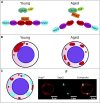Septins in Stem Cells
- PMID: 34957123
- PMCID: PMC8695968
- DOI: 10.3389/fcell.2021.801507
Septins in Stem Cells
Abstract
Septins were first described in yeast. Due to extensive research in non-yeast cells, Septins are now recognized across all species as important players in the regulation of the cytoskeleton, in the establishment of polarity, for migration, vesicular trafficking and scaffolding. Stem cells are primarily quiescent cells, and this actively maintained quiescent state is critical for proper stem cell function. Equally important though, stem cells undergo symmetric or asymmetric division, which is likely linked to the level of symmetry found in the mother stem cell. Due to the ability to organize barriers and be able to break symmetry in cells, Septins are thought to have a significant impact on organizing quiescence as well as the mode (symmetric vs asymmetric) of stem cell division to affect self-renewal versus differentiation. Mechanisms of regulating mammalian quiescence and symmetry breaking by Septins are though still somewhat elusive. Within this overview article, we summarize current knowledge on the role of Septins in stem cells ranging from yeast to mice especially with respect to quiescence and asymmetric division, with a special focus on hematopoietic stem cells.
Keywords: Borg; Cdc42; HSC; aging; polarity; septin; stem cells; yeast.
Copyright © 2021 Schuster and Geiger.
Conflict of interest statement
The authors declare that the research was conducted in the absence of any commercial or financial relationships that could be construed as a potential conflict of interest.
Figures

References
Publication types
LinkOut - more resources
Full Text Sources
Molecular Biology Databases
Miscellaneous

